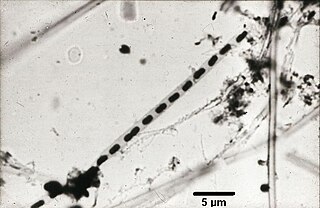
The Comamonadaceae are a family of the Betaproteobacteria. Like all Pseudomonadota, they are Gram-negative. They are aerobic and most of the species are motile via flagella. The cells are curved rod-shaped.

The Alteromonadales are an order of Pseudomonadota. Although they have been treated as a single family, the Alteromonadaceae, they were divided into eight by Ivanova et al. in 2004. The cells are straight or curved rods. They are motile by the use of a single flagellum. Most of the species are marine.
The Pseudoalteromonadaceae are a small family of Pseudomonadota.
The Colwelliaceae are a family of Pseudomonadota. This family consists of facultative anaerobes and has non-motile and motile members.
The Oceanimonas are a genus of marine bacteria. They are, like all Proteobacteria, gram-negative. The rod-shaped, motile organisms are aerobic and chemoorganotroph.
Hyphomonadaceae are a family of bacteria in the order Caulobacterales.
Algicola is a genus in the phylum Pseudomonadota (Bacteria).
The Hahellaceae are a family of Pseudomonadota in the order of Oceanospirillales.
Alkalimarinus is a Gram-negative genus of bacteria from the class of Alteromonadaceae with one known species. Alkalimarinus sediminis has been isolated from sediments from the coast of Weihai in China.
Phocoenobacter is a Gram-negative and rod-shaped genus of bacteria from the family of Pasteurellaceae with one known species. Phocoenobacter uteri has been isolated from the uterus of a harbour porpoise from Inverness in Scotland.
Williamwhitmaniaceae is a family in the order Bacteroidales.
Nitratifractor is a genus of bacteria from the order Campylobacterales, with one known species.
Alginatibacterium is a Gram-negative, strictly aerobic and rod-shaped bacteria genus from the family of Alteromonadaceae with one known species. Alginatibacterium sediminis has been isolated from coastal sediments.
Lacimicrobium is a Gram-negative, facultatively aerobic and motile bacteria genus from the family of Alteromonadaceae with one known species. Lacimicrobium alkaliphilum has been isolated from the Lake Xiaochaidan in the Qaidam Basin in China.
Neptunicella is a Gram-negative, aerobic and motile bacteria genus from the family of Alteromonadaceae with one known species. Neptunicella marina has been isolated from seawater from the Indian Ocean.
Planctobacterium is a Gram-negative, aerobic and motile bacteria genus from the family of Alteromonadaceae with one known species. Planctobacterium marinum has been isolated from the South China Sea.
Salinimonas is a bacterial genus from the family of Alteromonadaceae.
Tamilnaduibacter is a Gram-negative, halotolerant and rod-shaped bacteria genus from the family of Alteromonadaceae with one known species. Tamilnaduibacter salinus has been isolated from sediments from the Thamaraikulam solar salt pan from Tamilnadu in India.
Thiorhodovibrio is a Gram-negative genus of bacteria from the family of Chromatiaceae.
Thioreductor is a Gram-negative, mesophilic, hydrogen-oxidizing, sulfur-reducing and motile genus of bacteria from the phylum Campylobacterota with one known species. Thioreductor micantisoli has been isolated from hydrothermal sediments from the Iheya North from the Mid-Okinawa Trough in Japan.

